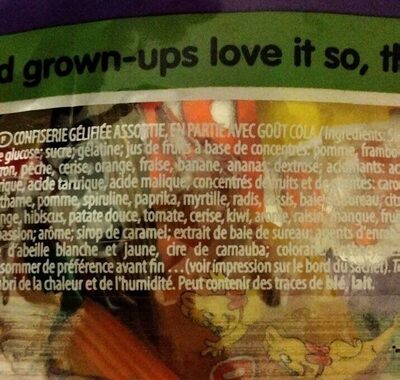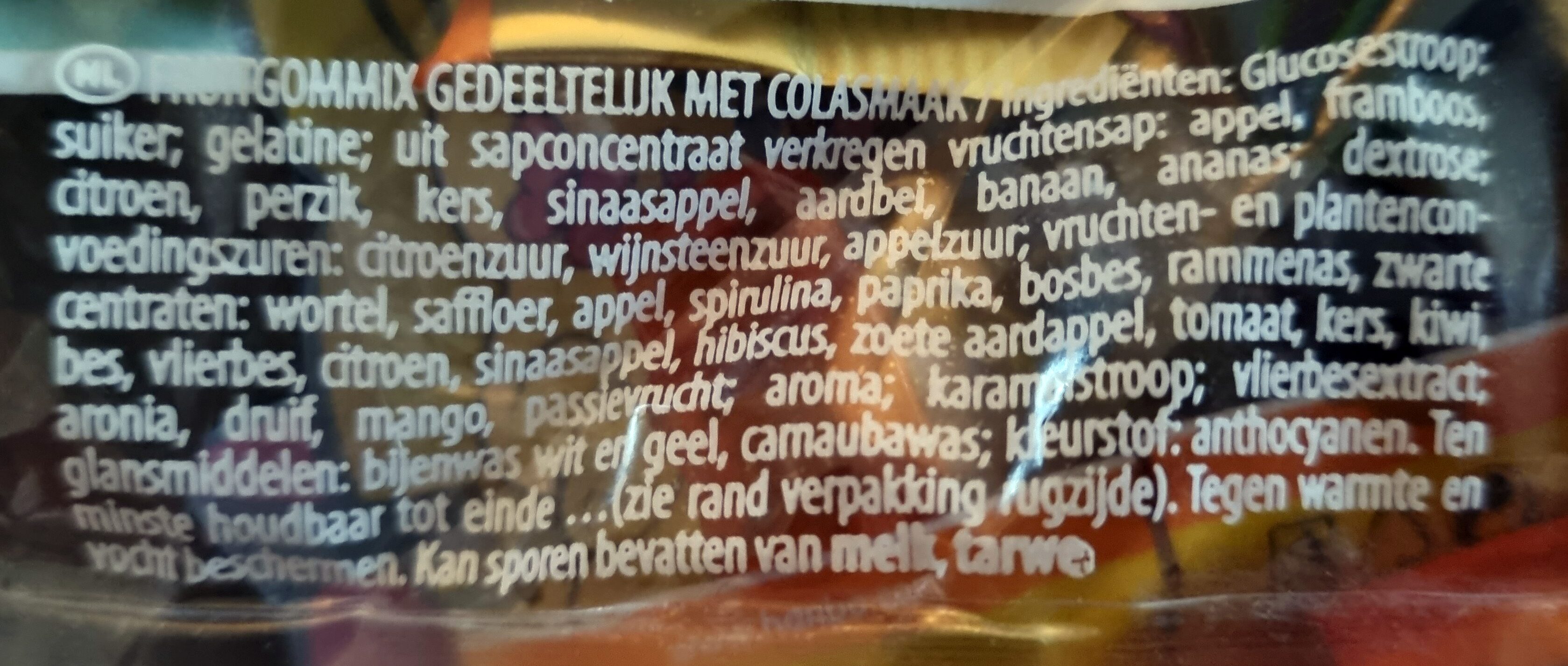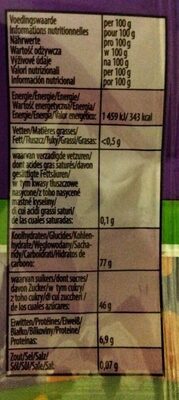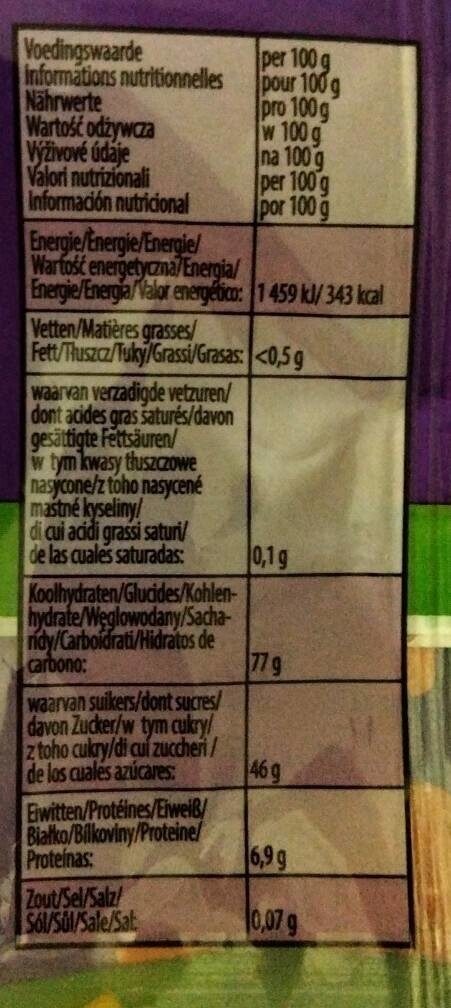Help us make food transparency the norm!
As a non-profit organization, we depend on your donations to continue informing consumers around the world about what they eat.
The food revolution starts with you!
Multipack size -
Multipack size -
This product page is not complete. You can help to complete it by editing it and adding more data from the photos we have, or by taking more photos using the app for Android or iPhone/iPad. Thank you!
×
Barcode: 4001686716762 (EAN / EAN-13)
Categories: Snacks, Sweet snacks, Confectioneries, Candies, Gummi candies
Countries where sold: Netherlands
Matching with your preferences
Health
Ingredients
-
45 ingredients
Dutch: Glucosestroop, suiker, gelatine; uit sapconcentraat verkregen vruchtensap: appel, framboos, citroen, perzik, kers, sinaasappel, aardbel, banaan, ananas; dextrose, voedingszuren: citroenzuur, wijnsteenzuur, appelzuur; vruchten - en plantenconcentraten: wortel, saffloer, appel, spirulina, paprika, bosbes, rammenas, zwarte bes, vlierbes, citroen, sinaasappel, hibiscus, zoete aardappel, tomaat, kers, kiwi, aronia, druif, mango, passievrucht; aroma: karamelstroop, vlierbesextract; glansmiddelen: bijenwas wit en geel, carnaubawas; kleurstof anthocyanenAllergens: Kiwi
Food processing
-
Ultra processed foods
Elements that indicate the product is in the 4 - Ultra processed food and drink products group:
- Additive: E163 - Anthocyanins
- Additive: E428 - Gelatine
- Additive: E901 - White and yellow beeswax
- Additive: E903 - Carnauba wax
- Ingredient: Colour
- Ingredient: Dextrose
- Ingredient: Flavouring
- Ingredient: Glazing agent
- Ingredient: Glucose
- Ingredient: Glucose syrup
Food products are classified into 4 groups according to their degree of processing:
- Unprocessed or minimally processed foods
- Processed culinary ingredients
- Processed foods
- Ultra processed foods
The determination of the group is based on the category of the product and on the ingredients it contains.
Additives
-
E163 - Anthocyanins
Anthocyanin: Anthocyanins -also anthocyans; from Greek: ἄνθος -anthos- "flower" and κυάνεος/κυανοῦς kyaneos/kyanous "dark blue"- are water-soluble vacuolar pigments that, depending on their pH, may appear red, purple, or blue. Food plants rich in anthocyanins include the blueberry, raspberry, black rice, and black soybean, among many others that are red, blue, purple, or black. Some of the colors of autumn leaves are derived from anthocyanins.Anthocyanins belong to a parent class of molecules called flavonoids synthesized via the phenylpropanoid pathway. They occur in all tissues of higher plants, including leaves, stems, roots, flowers, and fruits. Anthocyanins are derived from anthocyanidins by adding sugars. They are odorless and moderately astringent. Although approved to color foods and beverages in the European Union, anthocyanins are not approved for use as a food additive because they have not been verified as safe when used as food or supplement ingredients. There is no conclusive evidence anthocyanins have any effect on human biology or diseases.Source: Wikipedia
-
E296 - Malic acid
Malic acid: Malic acid is an organic compound with the molecular formula C4H6O5. It is a dicarboxylic acid that is made by all living organisms, contributes to the pleasantly sour taste of fruits, and is used as a food additive. Malic acid has two stereoisomeric forms -L- and D-enantiomers-, though only the L-isomer exists naturally. The salts and esters of malic acid are known as malates. The malate anion is an intermediate in the citric acid cycle.Source: Wikipedia
-
E330 - Citric acid
Citric acid is a natural organic acid found in citrus fruits such as lemons, oranges, and limes.
It is widely used in the food industry as a flavor enhancer, acidulant, and preservative due to its tart and refreshing taste.
Citric acid is safe for consumption when used in moderation and is considered a generally recognized as safe (GRAS) food additive by regulatory agencies worldwide.
-
E334 - L(+)-tartaric acid
Tartaric acid: Tartaric acid is a white, crystalline organic acid that occurs naturally in many fruits, most notably in grapes, but also in bananas, tamarinds, and citrus. Its salt, potassium bitartrate, commonly known as cream of tartar, develops naturally in the process of winemaking. It is commonly mixed with sodium bicarbonate and is sold as baking powder used as a leavening agent in food preparation. The acid itself is added to foods as an antioxidant and to impart its distinctive sour taste. Tartaric is an alpha-hydroxy-carboxylic acid, is diprotic and aldaric in acid characteristics, and is a dihydroxyl derivative of succinic acid.Source: Wikipedia
-
E901 - White and yellow beeswax
Beeswax: Beeswax -cera alba- is a natural wax produced by honey bees of the genus Apis. The wax is formed into "scales" by eight wax-producing glands in the abdominal segments of worker bees, which discard it in or at the hive. The hive workers collect and use it to form cells for honey storage and larval and pupal protection within the beehive. Chemically, beeswax consists mainly of esters of fatty acids and various long-chain alcohols. Beeswax has long-standing applications in human food and flavoring. For example, it is used as a glazing agent or as a light/heat source. It is edible, in the sense of having similar negligible toxicity to plant waxes, and is approved for food use in most countries and the European Union under the E number E901. However, the wax monoesters in beeswax are poorly hydrolysed in the guts of humans and other mammals, so they have insignificant nutritional value. Some birds, such as honeyguides, can digest beeswax. Beeswax is the main diet of wax moth larvae.Source: Wikipedia
-
E903 - Carnauba wax
Carnauba wax: Carnauba -; Portuguese: carnaúba [kaʁnɐˈubɐ]-, also called Brazil wax and palm wax, is a wax of the leaves of the palm Copernicia prunifera -Synonym: Copernicia cerifera-, a plant native to and grown only in the northeastern Brazilian states of Piauí, Ceará, Maranhão, Bahia, and Rio Grande do Norte. It is known as "queen of waxes" and in its pure state, usually comes in the form of hard yellow-brown flakes. It is obtained from the leaves of the carnauba palm by collecting and drying them, beating them to loosen the wax, then refining and bleaching the wax.Source: Wikipedia
Ingredients analysis
-
Palm oil free
No ingredients containing palm oil detected
Unrecognized ingredients: nl:aardbel, nl:karamelstroopSome ingredients could not be recognized.
We need your help!
You can help us recognize more ingredients and better analyze the list of ingredients for this product and others:
- Edit this product page to correct spelling mistakes in the ingredients list, and/or to remove ingredients in other languages and sentences that are not related to the ingredients.
- Add new entries, synonyms or translations to our multilingual lists of ingredients, ingredient processing methods, and labels.
If you would like to help, join the #ingredients channel on our Slack discussion space and/or learn about ingredients analysis on our wiki. Thank you!
-
Non-vegan
Non-vegan ingredients: E428, E901Some ingredients could not be recognized.
We need your help!
You can help us recognize more ingredients and better analyze the list of ingredients for this product and others:
- Edit this product page to correct spelling mistakes in the ingredients list, and/or to remove ingredients in other languages and sentences that are not related to the ingredients.
- Add new entries, synonyms or translations to our multilingual lists of ingredients, ingredient processing methods, and labels.
If you would like to help, join the #ingredients channel on our Slack discussion space and/or learn about ingredients analysis on our wiki. Thank you!
-
Non-vegetarian
Non-vegetarian ingredients: E428Some ingredients could not be recognized.
We need your help!
You can help us recognize more ingredients and better analyze the list of ingredients for this product and others:
- Edit this product page to correct spelling mistakes in the ingredients list, and/or to remove ingredients in other languages and sentences that are not related to the ingredients.
- Add new entries, synonyms or translations to our multilingual lists of ingredients, ingredient processing methods, and labels.
If you would like to help, join the #ingredients channel on our Slack discussion space and/or learn about ingredients analysis on our wiki. Thank you!
-
Details of the analysis of the ingredients
We need your help!
Some ingredients could not be recognized.
We need your help!
You can help us recognize more ingredients and better analyze the list of ingredients for this product and others:
- Edit this product page to correct spelling mistakes in the ingredients list, and/or to remove ingredients in other languages and sentences that are not related to the ingredients.
- Add new entries, synonyms or translations to our multilingual lists of ingredients, ingredient processing methods, and labels.
If you would like to help, join the #ingredients channel on our Slack discussion space and/or learn about ingredients analysis on our wiki. Thank you!
nl: Glucosestroop, suiker, gelatine, framboos, citroen, perzik, kers, sinaasappel, aardbel, banaan, ananas, dextrose, voedingszuren (citroenzuur), wijnsteenzuur, appelzuur, vruchten-en plantenconcentraten (wortel), saffloer, appel, spirulina, paprika, bosbes, rammenas, zwarte bes, vlierbes, citroen, sinaasappel, hibiscus, zoete aardappel, tomaat, kers, kiwi, aronia, druif, mango, passievrucht, aroma (karamelstroop), vlierbes, glansmiddelen (bijenwas wit en geel), carnaubawas, kleurstof (anthocyanen)- Glucosestroop -> en:glucose-syrup - vegan: yes - vegetarian: yes - ciqual_proxy_food_code: 31016 - percent_min: 2.5 - percent_max: 100
- suiker -> en:sugar - vegan: yes - vegetarian: yes - ciqual_proxy_food_code: 31016 - percent_min: 0 - percent_max: 46
- gelatine -> en:e428 - vegan: no - vegetarian: no - percent_min: 0 - percent_max: 33.3333333333333
- framboos -> en:raspberry - vegan: yes - vegetarian: yes - ciqual_food_code: 13015 - percent_min: 0 - percent_max: 25
- citroen -> en:lemon - vegan: yes - vegetarian: yes - ciqual_proxy_food_code: 13009 - percent_min: 0 - percent_max: 20
- perzik -> en:peach - vegan: yes - vegetarian: yes - percent_min: 0 - percent_max: 16.6666666666667
- kers -> en:cherry - vegan: yes - vegetarian: yes - ciqual_food_code: 13008 - percent_min: 0 - percent_max: 14.2857142857143
- sinaasappel -> en:orange - vegan: yes - vegetarian: yes - ciqual_proxy_food_code: 13034 - percent_min: 0 - percent_max: 12.5
- aardbel -> nl:aardbel - percent_min: 0 - percent_max: 11.1111111111111
- banaan -> en:banana - vegan: yes - vegetarian: yes - ciqual_food_code: 13005 - percent_min: 0 - percent_max: 10
- ananas -> en:pineapple - vegan: yes - vegetarian: yes - percent_min: 0 - percent_max: 9.09090909090909
- dextrose -> en:dextrose - vegan: yes - vegetarian: yes - ciqual_proxy_food_code: 31016 - percent_min: 0 - percent_max: 8.33333333333333
- voedingszuren -> en:acid - percent_min: 0 - percent_max: 7.69230769230769
- citroenzuur -> en:e330 - vegan: yes - vegetarian: yes - percent_min: 0 - percent_max: 7.69230769230769
- wijnsteenzuur -> en:e334 - vegan: yes - vegetarian: yes - percent_min: 0 - percent_max: 7.14285714285714
- appelzuur -> en:e296 - vegan: yes - vegetarian: yes - percent_min: 0 - percent_max: 6.66666666666667
- vruchten-en plantenconcentraten -> en:fruit-and-plant-concentrates - vegan: yes - vegetarian: yes - percent_min: 0 - percent_max: 6.25
- wortel -> en:carrot - vegan: yes - vegetarian: yes - ciqual_food_code: 20009 - percent_min: 0 - percent_max: 6.25
- saffloer -> en:safflower - vegan: yes - vegetarian: yes - percent_min: 0 - percent_max: 5.88235294117647
- appel -> en:apple - vegan: yes - vegetarian: yes - ciqual_food_code: 13050 - percent_min: 0 - percent_max: 5.55555555555556
- spirulina -> en:spirulina - vegan: yes - vegetarian: yes - ciqual_proxy_food_code: 20984 - percent_min: 0 - percent_max: 5.26315789473684
- paprika -> en:spice-or-bell-pepper - vegan: yes - vegetarian: yes - ciqual_food_code: 20041 - percent_min: 0 - percent_max: 5
- bosbes -> en:blueberry - vegan: yes - vegetarian: yes - ciqual_food_code: 13028 - percent_min: 0 - percent_max: 4.76190476190476
- rammenas -> en:black-radish - vegan: yes - vegetarian: yes - ciqual_food_code: 20089 - percent_min: 0 - percent_max: 4.54545454545455
- zwarte bes -> en:blackcurrant - vegan: yes - vegetarian: yes - ciqual_food_code: 13007 - percent_min: 0 - percent_max: 4.34782608695652
- vlierbes -> en:elderberry - vegan: yes - vegetarian: yes - ciqual_food_code: 13126 - percent_min: 0 - percent_max: 4.16666666666667
- citroen -> en:lemon - vegan: yes - vegetarian: yes - ciqual_proxy_food_code: 13009 - percent_min: 0 - percent_max: 4
- sinaasappel -> en:orange - vegan: yes - vegetarian: yes - ciqual_proxy_food_code: 13034 - percent_min: 0 - percent_max: 3.84615384615385
- hibiscus -> en:roselle-flower - vegan: yes - vegetarian: yes - percent_min: 0 - percent_max: 3.7037037037037
- zoete aardappel -> en:sweet-potato - vegan: yes - vegetarian: yes - ciqual_food_code: 4101 - percent_min: 0 - percent_max: 3.57142857142857
- tomaat -> en:tomato - vegan: yes - vegetarian: yes - ciqual_food_code: 20047 - percent_min: 0 - percent_max: 3.44827586206897
- kers -> en:cherry - vegan: yes - vegetarian: yes - ciqual_food_code: 13008 - percent_min: 0 - percent_max: 3.33333333333333
- kiwi -> en:kiwi - vegan: yes - vegetarian: yes - ciqual_food_code: 13021 - percent_min: 0 - percent_max: 3.2258064516129
- aronia -> en:chokeberry - vegan: yes - vegetarian: yes - percent_min: 0 - percent_max: 3.125
- druif -> en:grape - vegan: yes - vegetarian: yes - ciqual_food_code: 13112 - percent_min: 0 - percent_max: 3.03030303030303
- mango -> en:mango - vegan: yes - vegetarian: yes - ciqual_food_code: 13025 - percent_min: 0 - percent_max: 2.94117647058824
- passievrucht -> en:passionfruit - vegan: yes - vegetarian: yes - ciqual_food_code: 13016 - percent_min: 0 - percent_max: 2.94117647058824
- aroma -> en:flavouring - vegan: maybe - vegetarian: maybe - percent_min: 0 - percent_max: 2.77777777777778
- karamelstroop -> nl:karamelstroop - percent_min: 0 - percent_max: 2.77777777777778
- vlierbes -> en:elderberry - vegan: yes - vegetarian: yes - ciqual_food_code: 13126 - percent_min: 0 - percent_max: 2.77777777777778
- glansmiddelen -> en:glazing-agent - percent_min: 0 - percent_max: 2.63157894736842
- bijenwas wit en geel -> en:e901 - vegan: no - vegetarian: yes - percent_min: 0 - percent_max: 2.63157894736842
- carnaubawas -> en:e903 - vegan: yes - vegetarian: yes - percent_min: 0 - percent_max: 2.63157894736842
- kleurstof -> en:colour - percent_min: 0 - percent_max: 2.5
- anthocyanen -> en:e163 - vegan: yes - vegetarian: yes - percent_min: 0 - percent_max: 2.5
Nutrition
-
Bad nutritional quality
⚠ ️Warning: the amount of fiber is not specified, their possible positive contribution to the grade could not be taken into account.⚠ ️Warning: the amount of fruits, vegetables and nuts is not specified on the label, it was estimated from the list of ingredients: 12This product is not considered a beverage for the calculation of the Nutri-Score.
Positive points: 0
- Proteins: 4 / 5 (value: 6.9, rounded value: 6.9)
- Fiber: 0 / 5 (value: 0, rounded value: 0)
- Fruits, vegetables, nuts, and colza/walnut/olive oils: 0 / 5 (value: 12.6257932573426, rounded value: 12.6)
Negative points: 24
- Energy: 4 / 10 (value: 1459, rounded value: 1459)
- Sugars: 10 / 10 (value: 46, rounded value: 46)
- Saturated fat: 0 / 10 (value: 0.1, rounded value: 0.1)
- Sodium: 10 / 10 (value: 2400, rounded value: 2400)
The points for proteins are not counted because the negative points are greater or equal to 11.
Nutritional score: (24 - 0)
Nutri-Score:
-
Nutrient levels
-
Fat in low quantity (0.5%)
What you need to know- A high consumption of fat, especially saturated fats, can raise cholesterol, which increases the risk of heart diseases.
Recommendation: Limit the consumption of fat and saturated fat- Choose products with lower fat and saturated fat content.
-
Saturated fat in low quantity (0.1%)
What you need to know- A high consumption of fat, especially saturated fats, can raise cholesterol, which increases the risk of heart diseases.
Recommendation: Limit the consumption of fat and saturated fat- Choose products with lower fat and saturated fat content.
-
Sugars in high quantity (46%)
What you need to know- A high consumption of sugar can cause weight gain and tooth decay. It also augments the risk of type 2 diabetes and cardio-vascular diseases.
Recommendation: Limit the consumption of sugar and sugary drinks- Sugary drinks (such as sodas, fruit beverages, and fruit juices and nectars) should be limited as much as possible (no more than 1 glass a day).
- Choose products with lower sugar content and reduce the consumption of products with added sugars.
-
Salt in high quantity (6%)
What you need to know- A high consumption of salt (or sodium) can cause raised blood pressure, which can increase the risk of heart disease and stroke.
- Many people who have high blood pressure do not know it, as there are often no symptoms.
- Most people consume too much salt (on average 9 to 12 grams per day), around twice the recommended maximum level of intake.
Recommendation: Limit the consumption of salt and salted food- Reduce the quantity of salt used when cooking, and don't salt again at the table.
- Limit the consumption of salty snacks and choose products with lower salt content.
-
-
Nutrition facts
Nutrition facts As sold
for 100 g / 100 mlCompared to: Gummi candies Energy 1,459 kj
(343 kcal)+2% Fat 0.5 g +60% Saturated fat 0.1 g -30% Carbohydrates 77 g -4% Sugars 46 g -17% Fiber ? Proteins 6.9 g +100% Salt 6 g +4,818% Fruits‚ vegetables‚ nuts and rapeseed‚ walnut and olive oils (estimate from ingredients list analysis) 12.626 %
Environment
-
Eco-Score B - Low environmental impact
⚠ ️Select a country in order to include the full impact of transportation.The Eco-Score is an experimental score that summarizes the environmental impacts of food products.→ The Eco-Score was initially developped for France and it is being extended to other European countries. The Eco-Score formula is subject to change as it is regularly improved to make it more precise and better suited to each country.Life cycle analysis
-
Average impact of products of the same category: A (Score: 89/100)
Category: Jelly candy
Category: Jelly candy
- PEF environmental score: 0.21 (the lower the score, the lower the impact)
- including impact on climate change: 1.57 kg CO2 eq/kg of product
Stage Impact Agriculture
51.7 %Processing
31.1 %Packaging
7.6 %Transportation
7.3 %Distribution
2.3 %Consumption
0.0 %
Bonuses and maluses
-
Missing origins of ingredients information
Malus: -5
⚠ ️ The origins of the ingredients of this product are not indicated.
If they are indicated on the packaging, you can modify the product sheet and add them.
If you are the manufacturer of this product, you can send us the information with our free platform for producers.
-
Packaging with a medium impact
Malus: -10
Shape Material Recycling Impact Bag Unknown High ⚠ ️ The information about the packaging of this product is not sufficiently precise (exact shapes and materials of all components of the packaging).⚠ ️ For a more precise calculation of the Eco-Score, you can modify the product page and add them.
If you are the manufacturer of this product, you can send us the information with our free platform for producers.
Eco-Score for this product
-
Impact for this product: B (Score: 74/100)
Product: Multipack size -
Life cycle analysis score: 89
Sum of bonuses and maluses: -15
Final score: 74/100
-
Carbon footprint
-
Equal to driving 0.8 km in a petrol car
157 g CO² per 100g of product
The carbon emission figure comes from ADEME's Agribalyse database, for the category: Jelly candy (Source: ADEME Agribalyse Database)
Stage Impact Agriculture
36.9 %Processing
38.1 %Packaging
11.9 %Transportation
12.0 %Distribution
1.1 %Consumption
0.0 %
Packaging
-
Packaging with a medium impact
-
Packaging parts
Bag
-
Packaging materials
Material % Packaging weight
-
Transportation
-
Origins of ingredients
Missing origins of ingredients information
⚠ ️ The origins of the ingredients of this product are not indicated.
If they are indicated on the packaging, you can modify the product sheet and add them.
If you are the manufacturer of this product, you can send us the information with our free platform for producers.Add the origins of ingredients for this product Add the origins of ingredients for this product
Report a problem
-
Incomplete or incorrect information?
Category, labels, ingredients, allergens, nutritional information, photos etc.
If the information does not match the information on the packaging, please complete or correct it. Open Food Facts is a collaborative database, and every contribution is useful for all.
Data sources
Product added on by inf
Last edit of product page on by boterman76.
Product page also edited by aleene, annelotte, ecoscore-impact-estimator, kiliweb, yuka.sY2b0xO6T85zoF3NwEKvlkFWQdn9-m6caznQhRCBwN2gc7rhb85e0tjRFKs, yuka.sY2b0xO6T85zoF3NwEKvlm5edorkrBXENT3tlFeJndmNCZ7ZMMp1vLXgLqg.










